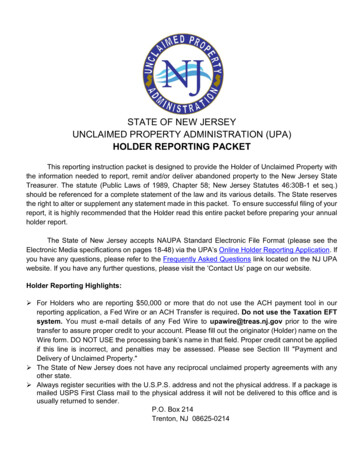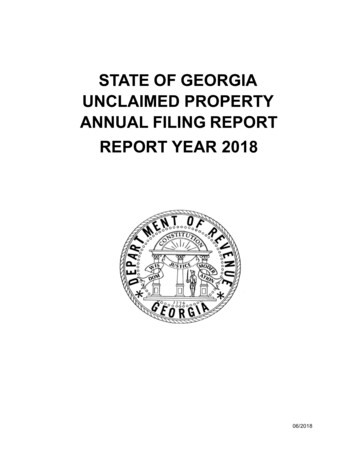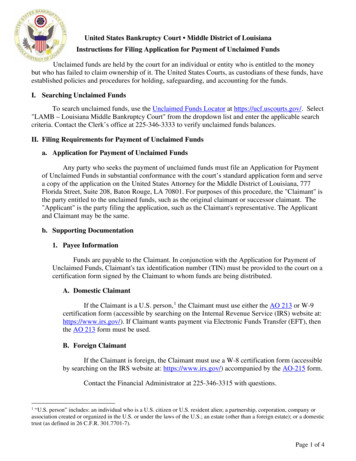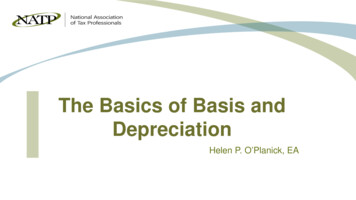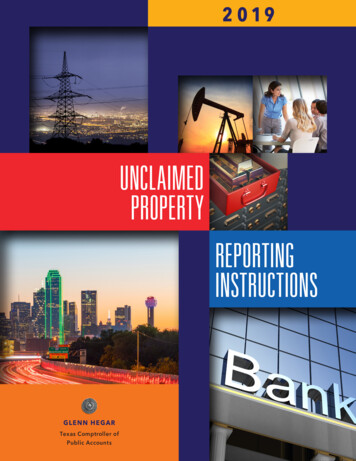
Transcription
2 019UNCLAIMEDPROPERTYREPORTINGINSTRUCTIONSG LE N N H EG A RTexas Comptroller ofPublic Accounts
UNCLAIMEDPROPERTYREPORTINGINSTRUCTIONS
iUnclaimed Property Reporting Instructions
Table of ContentsCHAPTER 1: INTRODUCTION TO HOLDER REPORTINGCHAPTER 3: PROPERTY-SPECIFIC REPORTINGWhat is Unclaimed Property?. 1Crime Victims Restitution. 11What is a Holder?. 2Escrow Funds Reported by Title Companies. 13Types of Unclaimed Property. 1What Are My Responsibilities as a Holder?. 2What You Need to File Your Report. 2Reporting Format. 2How Does the Reporting Process Work? . 3CHAPTER 2: FILING YOUR REPORTDetermining Dormancy. 5Notifying Property Owners. 6Other Methods of Verifying Whereaboutsof Owners. 6Preparing Your Report. 7Submitting Your Report and Payment. 7Archiving Data. 9Electric Cooperatives. 12Financial Institutions.14Insurance-Related Property.21Local Government. 24Mineral Proceeds. 24Mutual Fund Shares, Distributions and Checks. 25Securities or Securities-Related Cash.27CHAPTER 4: REFERENCE TABLESProperty Type Codes and Abandonment Periods.31Relationship Codes.33Suggested Abbreviations.35Property Description Codes. 36Securities Delivery Codes.38Country Codes.39Summary of Property Types andDormancy Periods.42County Codes To be used for reportingmineral proceeds.43Helpful Links.45Deadlines.45Unclaimed Property Reporting Instructionsii
iiiUnclaimed Property Reporting Instructions
Introduction to Holder ReportingCHAPTER 1CHAPTER 1Introduction to Holder ReportingWhat is Unclaimed Property?Unclaimed property can be any financial asset that hasbeen abandoned by the owner for periods ranging fromone to 15 years. The abandonment period is the numberof years that the property is held before being sent to theTexas Comptroller of Public Accounts (Comptroller’soffice). The property type determines the length of theabandonment period.Title 6 of the Texas Property Code governs the stateof Texas Unclaimed Property Program. Chapters 72through 77 apply to the reporting, delivery and claimsprocesses for abandoned property. Chapter 76 appliesonly to unclaimed property held and reported by Texascounties, municipalities, independent school districts andjunior colleges. Chapter 77 applies only to unclaimed crimevictims restitution payments held and reported by countyprobation departments.Types of Unclaimed PropertyUnclaimed property is classified into different propertytypes with different abandonment periods. All propertieslisted on your report must be assigned the correctproperty type codes. Your choice of codes is importantbecause it determines what type of information isrequired of claimants.Property Type Codes and Property DescriptionsWhen you are ready to prepare your report, select theproperty type code from Chapter 4: Reference Tables,Property Type Codes and Abandonment Periods section thatbest describes the original property of the owner. Use themiscellaneous outstanding check code (MS16) only as alast resort when the nature of the uncashed check is trulyunknown. Refer to the table entitled Property DescriptionField Requirements for the specific information requiredin the description field for each property type.Common Types of Unclaimed PropertyProperty Type:AbandonmentPeriod (Years)Payroll1Utility deposits1Demutualization proceeds1Uncashed dividend or cashier’s checks3Stocks, bonds, mutual fund accounts3Stored value cards (gift cards)3Bank accounts and matured certificatesof deposit3Insurance proceeds3Mineral interests or royalty payments3Court deposits, trust funds, escrow accounts3Money orders3Safe deposit box contents5Traveler’s checks15Unclaimed Property Reporting Instructions1
CHAPTER 1Introduction to Holder ReportingWhat is a Holder?A holder is any business in possession of propertybelonging to an individual or business.Holders may include: Mortgage and title companiesInsurance companiesOil and gas companiesSecurities brokersUtility providersLocal government entitiesInstitutions of higher educationWhat Are My Responsibilities asa Holder?Businesses (holders) who, on March 1, hold propertythat is presumed abandoned are required to file a reportof that property on or before the following July 1. TheComptroller’s office requires the report to be in theelectronic format developed by the National Associationof Unclaimed Property Administrators (NAUPA).Organizations that have determined they are not holdingabandoned property are not required to file a negative report.A negative report is a zero report showing that a business didnot have property to report for that year.Exception: county and probation departments will stillneed to file a negative report for crime victims restitutionpayments. (See page 11)The due date for unclaimed property reporting isJuly 1 of each year. We recommend a list of customerswith whom no contact has been reestablished be relayedto the person responsible for preparing your institution’sreport by June 1 (or whenever an internal deadline isset). All the information that you can provide for eachcustomer will assist in verifying ownership when a claimis generated.Source: Texas Property Code, Section 74.101What You Need to File Your ReportReport OverviewThere are five basic steps to follow when reporting anytype of property:1.2.3.4.5.Determining dormancyNotifying property ownersPreparing your reportSubmitting report and paymentArchiving dataReporting FormatYour report must be in the electronic reporting formatdeveloped by the NAUPA. The report can be created byusing any commercially available reporting software thatgenerates the file in the NAUPA format.For reports with a few properties, the Unclaimed PropertyDivision offers Manual Online Reporting (MOR).MOR can be located at ClaimItTexas.org, select “entera manual report” under the “reporting property” tab.Source: Texas Administrative Code, Title 34, Section 13-21Important Due DatesDeadlinesMarch 1 — annual cutoff date for requiredabandonment periods.June 30 — annual cutoff date for life insurance.July 1 —deadline for filing your report andremitting your property. Property maybe remitted any time after the Marchannual cutoff date.Nov. 1 — deadline for filing life insurance reportsand remitting property.Unclaimed property should not be reported until ithas reached the end of the abandonment period.If the due date falls on a weekend or holiday, the duedate will be the following business day.Source: Texas Property Code, Section 74.1012Unclaimed Property Reporting Instructions
Introduction to Holder ReportingCHAPTER 1How Does theReporting YOWNERSUnable to locate theowner. A businessis holding fundsthat are owed toan employee,client, vendor orcustomer.PREPARINGYOUR REPORTBy May 1, duediligence noticesare mailed, alertingowner that theirunclaimed propertywill be reported.Review records byMarch 1 to determineif contact was madewith owner afterabandonment period.5ARCHIVINGDATABusinesses arerequired to keepinformationrelating to reportedunclaimed propertyfor 10 years.4SUBMITTINGREPORT ANDPAYMENTIf owner is not foundafter due diligence,property must beincluded in the July 1report to the state.Unclaimed Property Reporting Instructions3
4Unclaimed Property Reporting Instructions
Filing Your ReportCHAPTER 2CHAPTER 2Filing Your ReportDetermining DormancyThe first step in the unclaimed property reportingprocess is to identify dormant accounts. For eachcustomer account or outstanding amount owed to aperson, you will need to determine the date of lastcontact. To do so: Locate the last documented communicationwith the owner Determine if the property is abandonedThen identify accounts where the date of last contact fallsoutside the abandonment period for that property type.When reviewing your records for abandoned property,look for the last documented communication or the lastdebit or credit generated by the owner on any property,not merely the property that is inactive.Contact with the owner may be established by mail,email, accessing an online account, in person or byphone. Phone contact must be documented in writingwith the date and time of the conversation. The fact thatmail is not returned to you by the post office does not,by itself, qualify as contact with that owner or activityon the account.Source: Texas Property Code, Section 72.101(a) andTexas Administrative Code, Title 34, Section 13.3For your July 1 report, use the following test to determineif a property is reportable:(As of the immediate past March 1)Example of DormancyAlpha Optical has the following accounts payablechecks: Beta Cleaning Company — 250.00, check dated12/31/2015, last date of contact 11/30/2015. Theyno longer handle your janitorial cleaning services. Charlie’s Coffee Company — 500.00, checkdated 12/31/2016, last date of contact waslast week.Accounts payable checks have a three-year dormancyperiod. Look at the last contact date for each of youroutstanding checks to determine if they have met thethree-year dormancy period and if you should reportthem in your 2019 unclaimed property report. Beta Cleaning Company — last contact datewas 11/30/2015 and the date of the check is12/31/2015. Last date of contact date of 11/30/15(plus 3 years – 11/30/18) falls between theunclaimed property reporting period of 3/2/2018and 3/1/2019. Report the 250.00 check on the2019 report. Charlie’s Coffee Company — last date of contactwas last week. Since you are continuing to dobusiness and have had recent contact with thecoffee company, do not report the 500.00 checkon your 2019 report. You should talk to Charlie’sCoffee Company accounting representative andexplain you have the outstanding check. Theyshould request you reissue the check.1. T he property has remained unclaimed for at least three years (oneyear for wages) and2. T here has been no contact with the owner during theabandonment period.Unclaimed Property Reporting Instructions5
CHAPTER 2Filing Your ReportNotifying Property OwnersThe second step in the reporting process is to notifythe property owner of each dormant account. Holdersare required to mail a notice to all owners of propertydue to be included in their annual report and valuedat more than 250. The notice must include thefollowing language:(1) You (the holder) are holding the property; and(2) y ou (the holder) may be required to deliver theproperty to the Comptroller’s office on or before July1 if the property is not claimed.The written notice must be mailed no later than May 1.Additional Information If owners claim their property before you file your report, remember to delete those records fromyour list of reportable property before filing yourannual report.The notice requirement does not apply to a holderthat has already mailed a letter to the missing ownerearlier in the abandonment period.If mail has been returned by the post office as aresult of a previous mailing, a second notice to thelast known address is not required.You are not required to mail notices to propertyowners entitled to 250 or less.No notice is required if you do not have record of anaddress.For properties valued at more than 250, postagecosts may be deducted from the cash amount owedto the missing owner.Postage deductions must be made from each owner’sproperty balance, a single deduction from the reporttotal is not permitted.Holders using commercial software products to createtheir report in the NAUPA format should enterdeduction code MC for mailing cost in the deductiontype field and the actual postage cost in the amountdeducted field. The net amount due the ownershould be entered in the amount remitted field.Source: Texas Property Code, Sections 74 .1011 and 77.0526Unclaimed Property Reporting InstructionsOther Methods of Verifying Whereaboutsof OwnersBefore mailing confirmation letters, remember thereare other methods to document your knowledge of thewhereabouts of owners even though there has been noowner-generated activity, such as letters or phone callsinitiated by the owners.Other methods the Comptroller’s office recognizes are: Cross referencing your records to show that theindividuals have other active accounts with yourinstitution if customer profiles are not available Signed W-9 Forms, change-of-address notices orother correspondence A telephone log that states the dates and times youspoke directly with the account owners ACH debits or credits generated by the owner Contact with the owner established by mail, email,accessing an online account or by phone. Phonecontact should be documented in writing and includethe date and time of the conversation.Internal credits (e.g., for certificates of deposit interest)or debits (e.g., for safe deposit box rent) generated byyour institution are not sufficient for verification ofowner activity.REMEMBER: If you have had contact with the owners,do not include them on your report.
Filing Your ReportCHAPTER 2Preparing Your ReportSubmitting Report and PaymentThe third step in the reporting process is to prepareyour report. All property not previously reported to theComptroller’s office and unclaimed for the applicableperiod of abandonment or longer should be included inyour report. Holders are required to report all availableowner information. The last contact date, relationshipcode, Social Security numbers, last known addressesand property descriptions are important for verifyingownership during the claims process. If you do notinclude the last contact date and relationship code,your report will be rejected. Submitting as muchinformation as possible with your report reduces theneed for us to contact you for additional information.The fourth step in the reporting process is to submitthe report and payment. Property reports must besubmitted to the Comptroller’s office via secure filetransfer portal in the NAUPA format via our securedwebsite, ClaimItTexas.org by July 1.Holders are allowed to report individual owner recordsof less than 25 value in aggregate. You may combineamounts under 25 by property type and provide a singletotal for each property type. Do not combine differentproperty types into one aggregate record.The property type code used on an aggregate recordshould always end in “99” (e.g., AC99 or IN99). In thedescription field of an aggregate record, list the numberof properties that you combined for the aggregate entryand the property type. For example, an AC99 recordwith “15 AC01” entered in the description field indicates15 checking accounts are aggregated on one record.If an owner files a claim for an amount less than 25that you reported in the aggregate, our office willcontact you for verification that the owner’s property wasincluded in your aggregate total.Reports will be subject to rejection if the data does notcomply with these standards. If rejected, holders have upto 30 days to resubmit corrected reports. Holders failingto resubmit corrected reports within 30 days may besubject to a daily penalty.After the transmission is complete, you will receive twonotifications. The first is the Holder Summary which isdisplayed on your screen immediately after submission.You will receive the second notification in an emailcontaining your confirmation/report ID number shortlyafter submission.The confirmation number must be included with yourpayment. If the transmission fails, a message displaysindicating there was a problem. If your transmissioncontinues to fail, please contact the Holder Reportingand Education Section at 800-321-2274, Option 2,for assistance.NOTE: The maximum size for the report is 250 MB.Source: Texas Administrative Code, Title 34, Section 13.21NOTE: Though allowed by statute, aggregatedproperty omits individual owner names. Withoutowner names, it is very difficult for Comptroller staffand owners to locate their property. For this reason,aggregating property is discouraged.Accessible forms can be found at: ClaimItTexas.org/app/forms-holder.Source: Texas Property Code, Sections 74.101(d), 74.501and 77.201Unclaimed Property Reporting Instructions7
CHAPTER 2Filing Your ReportPayment and DeliveryTexas law allows holders of unclaimed property to remitpayments by check or electronically with an automatedclearinghouse (ACH) debit or credit through the Stateof Texas Financial Network, TEXNET. Holders whoremit more than 100,000 in unclaimed property arerequired to make their payments electronically.Enrollment in the TEXNET Program, specific forunclaimed property, is required prior to sending ACHpayments. Texas enrollment information can be found 141.pdf.The last day to enroll is June 30 before 6 p.m. (CST) tomeet the July 1 deadline. If you are currently enrolled forunclaimed property, go to https://texnet.cpa.state.tx.us,to initiate your payment. Your remittance can bescheduled up to 30 days before your payment is due. Theinformation will be given in a pending status, and yourfunds are not transferred until the date you designate.Checks should be made payable to:Texas Comptroller of Public AccountsUnclaimed PropertyRemittances should be mailed to:Texas Comptroller of Public AccountsUnclaimed Property DivisionP.O. Box 12019Austin, Texas 78711-2019Physical address for courier delivery of remittance:Texas Comptroller of Public AccountsUnclaimed Property Division111 E. 17th St.Austin, Texas 78774-0100Deliver tangible property to:Texas Comptroller of Public AccountsUnclaimed Property208 E. 10th St., Room 232AAustin, Texas 78701-24078Unclaimed Property Reporting InstructionsHolder Refund and Reimbursement RequestHolders may request a refund of property amountsreported in error, e.g. prior to the end of theabandonment period. Holders may also be reimbursedfor returning erroneously reported properties directlyto an owner.The Holder Refund and Reimbursement Requestform can be found at ClaimItTexas.org/app/forms-holder.Source: Texas Property Code, Section 74.502Exception — Missed Your TEXNETPayment Deadline?When payment information for ACH debittransactions cannot be submitted before 6 p.m. (CST)on the bank business day before the due date, or whenACH credit with addenda transactions cannot beoriginated for settlement on the due date, you must usethe following procedure to ensure a timely payment:1.2.Report payment information as early aspossible on the payment due date by calling theTEXNET hotline at 800-531-5441, ext. 3-3010.This call is very important – without it, we will nothave the necessary information to apply the paymentto your unclaimed property account.Instruct your financial institution to wire transferyour payment to:Bank name: T exas Comptroller ofPublic AccountsRouting #: 114900164Account name: Texas Comptroller ofPublic AccountsAccount #: 883083001The Comptroller of Public Accounts is the receivingbank, located in Austin, Texas. You must includeyour holder name and taxpayer identification numberin the wire, as well as the name of a contact personand phone number.
Filing Your ReportInterest and Penalty on Late RemittancesHolders who fail to pay property on time will be assessedinterest and penalty from the date the property shouldhave been paid until the date it is received in our office.Interest and penalty for late filing is based on the datethe property is paid to our office. We recommend thatyou file a report immediately if you determine you areholding property that should have been paid in previousyears. The Comptroller’s office will calculate the interestand penalty and forward a bill for any amount owed.Source: Texas Property Code, Sections 74.705 and 74.706CHAPTER 2Archiving DataThe last step in the reporting process is to archivethe information included in the report. All holdersare required to retain unclaimed property records for10 years after the property was reportable. You maybe contacted by Comptroller staff to verify previouslyreported information.It is important that you keep records of owners’ lastknown addresses, even though the post office may havereturned their mail. This information is required to assistclaimants in verifying ownership of their property.Source: Texas Property Code, Section 74.103For questions or assistance, contact ourHolder Reporting and Education Section at:up.holder@cpa.texas.govOR800-321-2274, Option 2For tangible property questions or assistance, contact SafeDeposit Box staff at:unclaimed.auction@cpa.texas.govOR800-321-2274, Option 2, then Option 3Unclaimed Property Reporting Instructions9
10 Unclaimed Property Reporting Instructions
Property-Specific ReportingCHAPTER 3CHAPTER 3Property-Specific ReportingCrime Victims RestitutionCounty and probation departments are required to filecrime victims restitution payments electronically byJuly 1 of each year. If the due date falls on the weekendor holiday, the due date will be next business day.In addition, departments are required to mail a notice toall owners of property that is due to be included in theirannual report. The written notice must be mailed nolater than May 1. If owners claim their property prior toremitting your report, delete their records from your listof reportable property before filing your annual report.Reporting Annual ReportNOTE: Information relating to unclaimed restitutionRestitution payments are presumed abandoned in thefollowing instances:If there is no property to report, a negative report If an owner does not make a claim for paymentbefore the fifth anniversary of the date thedepartment received the initial restitution payment.payments will be kept confidential.is required.Source: Texas Property Code, Section 77.051 The department is unable to locate the owner for aperiod of five years after the date the department lastmade a payment to the owner.Once restitution payments meet these requirements,departments are required to file a report with theComptroller’s office by July 1 of each year.All unclaimed restitution payments reaching the end ofthe five year abandonment period (last date of contactbetween March 2, 2013, and March 1, 2014) must bereported electronically by July 1, 2019. If known by thedepartment, reports should include: The name, SSN, driver’s license or state identificationnumber, email address and last known address of theowner entitled to the restitution payment; The cause number of the case in which the judgeordered the restitution payment; The amount of restitution ordered and the balanceowed to the owner; and The date of the department’s last contact withthe owner.Unclaimed Property Reporting Instructions 11
CHAPTER 3Property-Specific ReportingElectric CooperativesTexas nonprofit electric cooperatives have the option toredirect a portion of their reportable unclaimed propertyto one or more of the following three specific fundscreated to assist their communities. Rural scholarship Economic development Energy efficiency assistanceIn April of each year, information regarding the transferrequests are mailed to each electric cooperative. Thecompleted requests from the cooperatives are due byJune 1.In addition to your remittance report, a separate nonremittance report must be submitted for each fund thecooperative chooses to redirect funds providing thereported property owners’ names, property information,and amounts due to the Comptroller’s office on orbefore July 1.Capital credits are property type (UT04). Electriccooperatives reporting capital credits should enter thenumeric county code of service in the country field sothat redirected funds can be properly allocated to eachowner’s county of service. County codes should notbe included on scholarship reports, energy efficiencyassistance reports or economic development reports.When entering county codes, be sure to use all threedigits (i.e., 005, 027, 099). Refunds (UT03) do notrequire a county code.If you have the county code information available for theaggregated capital credits, create a separate aggregaterecord for each county and enter the county name in thedescription field.Source: Texas Property Code, Section 74.301312Unclaimed Property Reporting Instructions
Property-Specific ReportingEscrow Funds Reported byTitle CompaniesIn addition to wages and uncashed checks, titlecompanies should report escrow accounts, which have notbeen claimed and have had no activity or current contactwith the owner for three years. Funds in active litigationshould not be reported. The three-year abandonmentperiod commences on the date of last contact with theowner or on the date of the last owner-generated activity.Escrow FundsEscrow balances include accounts where you hold moneybecause of the nonperformance of the conditions ofthe escrow agreement. Generally, amounts placed inescrow at closing should be reported in the name ofthe party who provided the funds. A portion of theseller’s payoff held to ensure all taxes were paid andrepairs were completed is one example. Once the taxesare paid, repairs are made or other conditions of theescrow agreement are met and funds remain unclaimed,the seller’s name would be reported as the owner of theunclaimed amount. The buyer would not be entitled tothe funds.NOTE: Service or maintenance fees may not bededucted from funds that are subsequently reportedas unclaimed property unless stipulated in the contractand acknowledged by the signatures on the contract.CHAPTER 3Earnest MoneyThe Texas Department of Insurance advises that disputedearnest money should be interpleaded into the appropriatecourt registry. Even in a situation where one of theclaimants cannot be located, the court may be able toenter a default judgment disposing of the earnest money.In transactions involving earnest money, both the buyerand the seller have an undivided interest in the entireamount. Therefore, both the buyer and the seller areconsidered the owner under the statute, and both parties’names should be listed on your report. The person whoplaced the money in escrow – usually the buyer –should be reported as the primary owner. The otherparties should be listed as additional owners. If youhave communicated with both the buyer and the sellerwithin the last three years, and they cannot agreeon the disposition of the funds, the account wouldnot be considered unclaimed property and shouldnot be remitted.If the contract stipulates that the seller may claimthe funds under specific conditions, and documentingevidence in your file indicates that those conditionsexist, the seller’s name would be listed as the ownerin your report. The buyer would not be listed as anadditional owner.If you have contact with one party but a release cannotbe secured from the missing party, the funds should bereported three years from the date of last contact withthe missing party or date of scheduled closing. If oneparty believes he or she is entitled to the funds, the claimis not diminished when the funds are remitted. If youhave contact with both the buyer and the seller, the fundsshould not be reported.Earnest money and other escrow funds should bereported using property type code TR04. For othertypes of property you report, select the property typecode that best describes the original property of themissing owner. The miscellaneous outstanding checkcode (MS16) should be used only as a last resort whenthe nature of the uncashed check is truly unknown.Unclaimed Property Reporting Instructions 13
CHAPTER 3Property-Specific ReportingFinancial InstitutionsFinancial institutions include banks, savings andloans, state credit unions and federal credit unions.Organizations such as federal land banks or personalfinance companies are not included in this group for thepurposes of this chapter.Abandonment PeriodsProperty reportable by financial institutions hasabandonment periods ranging from one to five years.AbandonmentPeriodProperty des, but is not limited to: all types of checking and savings accounts, matured certificates of deposit, money orders and most types ofuncashed checks, trust-related properties, investment andescrow accounts, all types of securities-related properties, sums payable under pension andprofit-sharing plans, safekeeping properties, loan collateral, and miscellaneous types of unclaimed propertysuch as accounts payable checks andunidentified deposits.Five-YearProperty:Abandoned safe deposit box contents.Preservation of Inactive Account orSafe Deposit BoxA depository is responsible for preserving safe depositbox contents and accounts that are inactive. Thedepository may not reduce the value of the account orthe contents of the box. Value is determined as of thedate the account or safe deposit box becomes inactive.Source: Texas
22 Unclaime opert Reportin nstructions What is a Holder? A holder is any business in possession of property belonging to an individual or business. Holders may include: Mortgage and title companies Insurance companies Oil and gas companies Securities brokers Utility providers Local government entities Institutions of higher education


